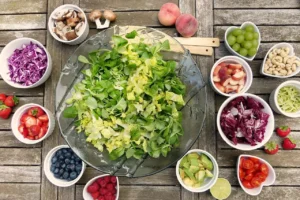Plant-derived proteins offer essential amino acids directly absorbed by the body. Furthermore, these may help lower risks of heart disease, obesity and other chronic illnesses (7).
Legumes (beans, peas and lentils) and soy foods provide nutritionally dense proteins that make excellent additions to meals. Try incorporating them into breakfast bowls, soups or salads!
1. Soy
Soybean (legumes) products are an excellent plant-based source of protein, providing your body with all of the essential amino acids it requires for proper functioning. Furthermore, soy provides folate, potassium and fiber too – popular foods containing soybean protein include edamame (whole soybeans), tofu, soy milk, soy sauce and tempeh. Regular consumption may help lower total cholesterol, low-density lipoproteins (LDLs) and triglycerides levels
Chickpeas (commonly referred to as garbanzo beans) are another great plant-based protein source, boasting 13 grams per cup in addition to being high in fiber. As an easy snack or addition to soups and salads, try hummus as a snack! You could also stir hemp hearts into oatmeal or yogurt; smoothies; sprinkle them over roasted veggies, soups and stews or just enjoy as is for their added omega-3 fatty acids, magnesium and potassium benefits!
2. Lentils
Dry lentils might seem daunting when opening your pantry, but these little powerhouses of nutrition are straightforward and a fantastic source of protein. Use them in salads or as the foundation of vegetable-packed soup for delicious meat-free meals!
Lentils, like their legume counterparts beans, chickpeas and sugar snap peas, provide a wide array of essential vitamins and nutrients – fiber, iron, folate, magnesium and potassium are among them – making them a nutritious alternative to meat such as beef or pork as they’re low in saturated fat and provide “an essential source of heart-healthy unsaturated fatty acids,” as per the American Heart Association.
A 1/2 cup of cooked lentils offers approximately 13 grams of protein. Green lentils have the advantage of being more resilient after being cooked and their mild flavor makes them suitable for salads or soups, while yellow ones cook quickly and tend to turn mushy quickly when exposed to heat, making them great for Indian and Middle Eastern dishes. Finally, black lentils have deeper colors with deeper flavors making a hearty side dish or an addition to stews.
3. Chickpeas
Chickpeas (Cicer arietinum) and black-eyed peas are legumes rich in protein and fiber that may help with weight management by decreasing appetite, leading to reduced caloric consumption at meals. Furthermore, chickpeas promote bone health thanks to vitamin K and folate content as well as being filling.
Chickpeas and black-eyed peas make delicious additions to salads, soups, stews and casseroles as well as delicious oven-roasted and salted snacks – you could even transform them into delicious hummus!
Tofu, made from soybeans, is another rich source of protein. You can incorporate tofu into soups, stews, stir fries or vegetarian burgers or use it in place of meat in pasta dishes for an alternative protein source. Or try tempeh which is firm tofu baked into nuggets!
Though not all plant proteins can be considered complete, consuming a wide range of plant-based foods throughout the day should provide enough essential amino acids. You can incorporate whole food sources of protein like beans and soy into your diet or experiment with plant-based protein powders, concentrates, or isolates which tend to contain higher indispensable amino acid contents than their whole-food counterparts and thus may help meet protein needs more effectively.
4. Hemp Hearts
Just as chia and flax seeds have gone from hipster products found at the back of Whole Foods to pantry essentials, hemp hearts may follow suit and become mainstream products. Sourced from Cannabis sativa plants, these unshelled or hulled seeds boast high amounts of essential nutrients – including an impressive 10 grams per tablespoon serving (half the protein found in an average egg)!
These foods also provide heart-healthy omega-3 fatty acids that are vital to brain function. Furthermore, they contain magnesium, iron and vitamin B1 to support immune health.
Hemp hearts bring crunch and mild, sweet nutty flavor to salads, yogurt and oatmeal, according to Siva. You can sprinkle them over acai bowls or use them in place of sesame seeds in any recipe that calls for nuts or seeds – even spooning into sauces to add texture and protein or using as pasta garnish – although be mindful not to go overboard despite their nutritional power! Remember they do contain high amounts of fat!
5. Quinoa
Quinoa stands out among whole grains as a versatile whole food because it contains all nine essential amino acids that the human body cannot produce on its own. Furthermore, it’s an excellent source of magnesium and iron.
To maximize its nutritional value, combine it with other plant-based foods. This will ensure you meet your protein requirements and offer your body more complete package of fiber, healthy fats, calcium, folate and B vitamins.
Plant-based diets can not only benefit the environment, but they may also help prevent cancer, heart disease, diabetes and other chronic illnesses. Fiber content helps you control weight and consume less. If you want to try becoming vegan or vegetarian for yourself, start slowly adding plant-based proteins into meals so your gut has time to adapt; eventually you’ll find out which ones work best with your body for a delicious and satiating diet that supports overall wellbeing and health.




